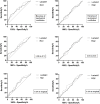Respiratory quotient as an early predictor of length of stay after cardiac surgery: A prospective observational study
- PMID: 39828259
- PMCID: PMC11742601
- DOI: 10.6133/apjcn.202502_34(1).0006
Respiratory quotient as an early predictor of length of stay after cardiac surgery: A prospective observational study
Abstract
Background and objectives: This study aimed to investigate the respiratory quotient (RQ) levels and its trend in the early postoperative period of patients with heart disease. Additionally, we explored factors influencing RQ and evaluated the predictive capabilities of RQ and lactic acid for various outcomes.
Methods and study design: In this prospective observational study, participants included were heart disease patients aged 18-80 years who underwent elective open-heart surgery and were subsequently admitted to the cardiothoracic surgery ICU post-operation. Indirect calorimetry (IC) measurements were conducted on patients dur-ing the first three days after surgery to assess their RQ levels. Clinical data, including personal information, postoperative characteristics, and duration of surgery, were documented based on the patient's medical history.
Results: In this study, 135 patients, of whom 57.04% were male, underwent a total of 247 IC measurements following cardiac surgery. On the first, second, and third days of admission to the ICU, the RQ values were 0.77±0.09, 0.80±0.07, and 0.78±0.05, respectively. The ROC curve analysis showed that on the first day of admission to the ICU, RQ was a better predictor of prolonged mechanical ventilation, LOS in ICU, and LOS in hospital compared to lactate level. However, on the second day of ICU admission, neither RQ nor lactate level could predict longer durations of mechanical ventilation, LOS in ICU, and LOS in hospital.
Conclusions: RQ may serve as a potential predictor for LOS in patients after cardiac surgery.
Keywords: serum lactate; cardiac surgery; indirect calorimetry; length of stay; respiratory quotient.
Conflict of interest statement
The authors declare no conflict of interest
Figures




Similar articles
-
Prognostic value of respiratory quotients in severe polytrauma patients with nutritional support.Nutrition. 2018 May;49:90-95. doi: 10.1016/j.nut.2017.10.013. Epub 2017 Nov 7. Nutrition. 2018. PMID: 29500970
-
An elevated respiratory quotient predicts complications after cardiac surgery under extracorporeal circulation: an observational pilot study.J Clin Monit Comput. 2019 Feb;33(1):145-153. doi: 10.1007/s10877-018-0137-0. Epub 2018 Apr 17. J Clin Monit Comput. 2019. PMID: 29667097
-
Factors associated with prolonged length of stay following cardiac surgery in a major referral hospital in Oman: a retrospective observational study.BMJ Open. 2016 Jun 8;6(6):e010764. doi: 10.1136/bmjopen-2015-010764. BMJ Open. 2016. PMID: 27279475 Free PMC article.
-
Effectiveness of dexmedetomidine versus propofol on extubation times, length of stay and mortality rates in adult cardiac surgery patients: a systematic review and meta-analysis.JBI Database System Rev Implement Rep. 2018 May;16(5):1220-1239. doi: 10.11124/JBISRIR-2017-003488. JBI Database System Rev Implement Rep. 2018. PMID: 29762314
-
Early tracheostomy in intensive care trauma patients improves resource utilization: a cohort study and literature review.Crit Care. 2004 Oct;8(5):R347-52. doi: 10.1186/cc2924. Epub 2004 Aug 23. Crit Care. 2004. PMID: 15469579 Free PMC article. Review.
References
Publication types
MeSH terms
Substances
Grants and funding
LinkOut - more resources
Full Text Sources
Medical

